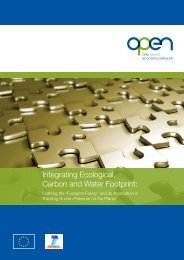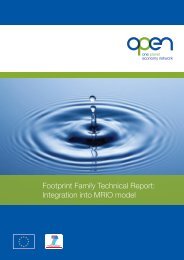OPEN: EU Scenario Storylines Report: - One Planet Economy Network
OPEN: EU Scenario Storylines Report: - One Planet Economy Network
OPEN: EU Scenario Storylines Report: - One Planet Economy Network
You also want an ePaper? Increase the reach of your titles
YUMPU automatically turns print PDFs into web optimized ePapers that Google loves.
Consumption and waste<br />
� Footprint Tax. In this <strong>Scenario</strong>, the Footprint Tax (reflecting the Ecological,<br />
Carbon and Water footprint of the product or service), needed to be higher than in<br />
<strong>Scenario</strong> 1, due to the lower level of technological innovation. The tax reached up<br />
to 85% of the product‘s value in 2050. As a result, the consumption of electronic<br />
goods, for example, is very low in this scenario. There is a wide culture of repair<br />
and reuse, reinforcing a strong closed loop economy.<br />
� Advanced labelling. Labelling and pricing of resources, goods and services has<br />
taken into account the environmental and social harm caused during extraction,<br />
production and use, including impacts on biodiversity, ecosystem services, air and<br />
water quality, and scarcity of finite resources.<br />
� Household waste measures. As in <strong>Scenario</strong> 1, the <strong>EU</strong> required that Member<br />
States encourage municipalities to reduce waste collection services to a biweekly<br />
instead of a weekly scheme and to offer door-to-door recycling collection on a<br />
weekly basis. This reduction in services resulted in an immediate 20% reduction<br />
in the amount of household waste generated and had a longer-term effect of<br />
fostering a culture of zero waste households.<br />
Industrial policy<br />
� Raw material taxation. Similar to <strong>Scenario</strong> 2, an international agreement made<br />
it possible to harmonise the taxation of raw material inputs with the highest<br />
environmental impact. The shift in focus towards the Beyond GDP model in this<br />
<strong>Scenario</strong> meant that the tax rate did not have to reach as high a level (reaching<br />
20% by 2040).<br />
� Carbon taxes. In this <strong>Scenario</strong>, the general trend away from the emphasis on<br />
markets and private sector competition results in a carbon tax system being<br />
introduced to replace the <strong>EU</strong> ETS as the main carbon policy instrument. In<br />
addition to the carbon footprint tax imposed on products and services (described<br />
above), carbon taxes were imposed on many industrial sectors at the point source<br />
of emissions from 2020 onwards to drive efficiency improvements and the<br />
diffusion of alternative technologies where available.<br />
� Recycled content purchasing regulation. Beginning in 2020, a wholesaler and<br />
retailer purchasing obligation mandated that products must contain a minimum of<br />
20% recycled materials (increased to 50% by 2040).<br />
Water resources<br />
� Full cost recovery water pricing. (Financial, resource and environmental<br />
costs). Under the <strong>EU</strong> Water Pricing Directive, Member States are required to<br />
ensure full cost recovery water pricing in household, agricultural, and industrial<br />
(including mining) sectors. Under a stepwise increase between 2015 and 2050,<br />
average water pricing for public water/wastewater services in non-water scarce<br />
<strong>EU</strong> regions is 7 <strong>EU</strong>R/m³; in water scarce regions, it is of 10 <strong>EU</strong>R/m³.<br />
� Water pricing and shift of water-related energy subsidies to R&D.<br />
Agriculture and industry voluntarily redirected water pricing and energy subsidies<br />
to R&D.<br />
� Scarcity & drought bands and quotas. Imposed during the summer season<br />
and during any other times of water scarcity and drought in water scarce regions<br />
to reduce average per capita water consumption to 300 m³/ year. An additional<br />
ban on water cooling restricted power generation in Southern Europe and England<br />
to dry cooling only.<br />
Page 43 of 57





